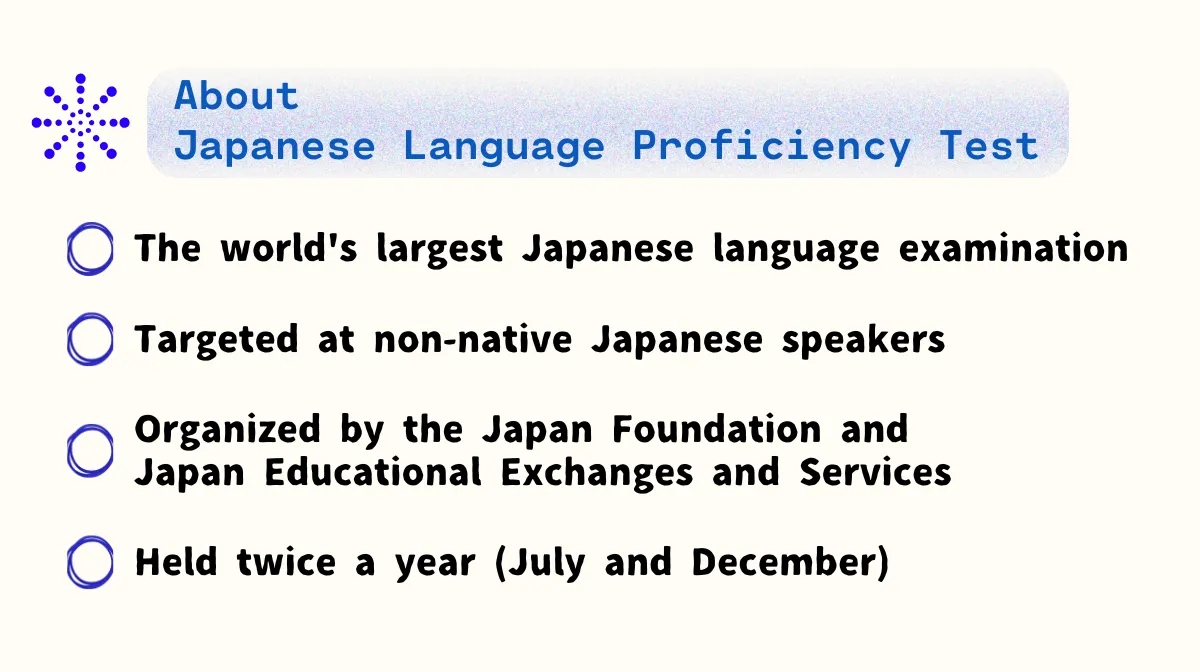The Japanese Language Proficiency Test (JLPT) significantly impacts the careers of foreign IT engineers, affecting visa acquisition, salary increases, and expanding job opportunities.
This article comprehensively introduces what IT engineers should know about utilizing the JLPT, from the characteristics of each level (N1-N5) to how the test is evaluated in the IT industry and practical learning methods.
1. Basic Information About the Japanese Language Proficiency Test (JLPT)

For foreign IT engineers, the Japanese Language Proficiency Test (JLPT) holds value beyond being just a language exam.
This qualification brings advantages in various situations such as job changes, promotions, and visa acquisition. We’ll explain everything from basic information to practical applications.
What is the JLPT? Purpose and Overview That Foreign IT Engineers Should Know
The Japanese Language Proficiency Test (JLPT) is the world’s largest Japanese language proficiency measurement and certification test for non-native speakers.
It is jointly administered by the Japan Foundation and the Japan Educational Exchanges and Services, held twice a year (July and December). The number of test-takers has grown from about 7,000 at its inception in 1984 to over 430,000 as of December 2022.
The reason it’s important for foreign IT engineers is that it works advantageously for employment, job changes, career advancement, and obtaining residence status.
The test is evaluated on a 5-level scale (N1 being the most difficult) and consists of three subjects: “Language Knowledge” “Reading” and “Listening”
In the IT industry, N2 or higher is generally required in many cases, although a high level is not always essential in workplaces where communication in English is possible.
International Recognition of the JLPT and its Evaluation in the IT Industry
The JLPT is the most internationally recognized Japanese language proficiency certification test, with CEFR level indicators scheduled to be added from 2025.
Evaluation in the IT industry varies by company and job type. While foreign IT companies tend to prioritize technical skills over Japanese language ability, Japanese IT companies often require N2 or higher, especially when customer interaction is necessary.
Required levels differ by IT field
- N3 level may be sufficient for roles where communication is not very important
- High Japanese language ability is required for consulting-related positions (particularly N1 level is often required for managerial, marketing, and sales positions)
- Advanced Japanese communication skills are considered important for positions that demonstrate leadership in a team
Testing Organizations and How to Get the Latest Information
The Japanese Language Proficiency Test is jointly administered by the Japan Foundation and the Japan Educational Exchanges and Services. The test is held twice a year (on the first Sunday of July and December).
The latest information can be obtained from the official website (Japanese and English versions), the official guidebook, and “My JLPT“
For IT engineers, blogs on tech job sites and IT-focused Japanese learning communities are also useful information sources. Utilizing online learning resources helps effective and efficient learning.
2. The Five Levels of the Japanese Language Proficiency Test (JLPT) and the Levels IT Engineers Need

The required Japanese language proficiency levels differ according to roles and job types in the IT industry, from N1 to N5 of the Japanese Language Proficiency Test (JLPT).
Here we explain the characteristics of each level and how they can be utilized in the IT industry.
N1: Advanced Level Capable of Understanding Technical Documents and Meetings
N1 is the most difficult level, allowing you to understand Japanese used in a wide range of situations.
At this level, you can understand texts including abstract concepts, logically complex content, business Japanese, and honorific expressions.
Knowledge of about 2,000 kanji and a vocabulary of over 10,000 words is required.
IT Engineers with <N1>
This can be utilized in situations such as reading and creating technical specifications and API documentation, technical discussions within teams, client interactions, working as project managers or tech leads, and technical presentations.
Reaching N1 level provides a significant advantage for career advancement in Japanese companies, but it’s a challenging level where even Japanese people find it difficult to get a perfect score. Even without perfection, you can be sufficiently valued when combined with technical skills.
N2: Pre-Advanced Level Necessary for Team Communication
N2 is often called the “business level,” enabling communication not only in daily conversation but also to a certain extent in business situations.
At this level, you can understand somewhat complex sentences and abstract content, requiring knowledge of about 1,000 kanji and a vocabulary of about 6,000 words.
There is a significant gap between N1 and N2, and considerable study is needed to step up from N3.
IT Engineers with <N2>
This can be utilized in situations such as participating in basic technical meetings, handling code reviews and pull requests, working in development environments where English and Japanese are mixed, and customer interactions.
Many Japanese companies consider N2 level as the standard for “Japanese language skills usable in business,” and obtaining N2 adds 10 points in the Highly-Skilled Professional Points-Based System, making it advantageous for obtaining residence status.
N3: Intermediate Level Capable of Understanding Basic Work Instructions
N3 is an intermediate level where you can understand Japanese commonly used in daily conversations to a certain extent.
You can understand slower-paced conversations and learn about 650 kanji and a vocabulary of about 3,750 words.
Stepping up from N4 to N3 requires significant effort as the vocabulary and kanji count nearly doubles.
IT Engineers with <N3>
This level enables understanding basic work instructions, participating in simple technical meetings, and development work in hybrid Japanese-English environments.
It may be sufficient for technical positions where communication is not very important (such as product engineering, embedded systems, etc.).
In recent years, more IT companies are hiring at the N3 level, and there is ample possibility of being hired in English environments, especially with high technical skills.
N4: Level Capable of Understanding Daily Conversation and Basic IT Terminology
N4 is the latter half of the beginner level, allowing you to understand basic Japanese.
You can understand daily content in slow-paced conversations and learn about 300 kanji and a vocabulary of about 1,500 words.
IT Engineers with <N4>
This level enables supplementary communication in workplaces where English is the main language, simple greetings and daily conversations, and understanding of basic IT terms (many of which are katakana words that are easy to understand).
Working in Japanese-only environments is difficult, but depending on technical skills, there’s a possibility of being hired by companies with English environments or international teams.
Also, obtaining N4 or higher certification is one of the prerequisites for acquiring the “Specified Skilled Worker” residence status.
N5: Level Capable of Understanding Elementary Greetings and Basic Words
N5 is the most basic level, allowing you to understand basic expressions in daily life when spoken slowly.
You learn about 100 kanji and a vocabulary of about 800 words, and can read and write hiragana, katakana, and basic kanji.
IT Engineers with <N5>
Working in a Japanese environment is difficult, but it demonstrates learning motivation. You can work in complementary roles in international companies where English is the official language or in workplaces where communication is primarily in English.
For long-term career development, it is recommended to improve Japanese language skills to at least N3, preferably N2 level.
■日本でエンジニアとしてキャリアアップしたい方へ
海外エンジニア転職支援サービス『 Bloomtech Career 』にご相談ください。「英語OK」「ビザサポートあり」「高年収企業」など、外国人エンジニア向けの求人を多数掲載。専任のキャリアアドバイザーが、あなたのスキル・希望に合った最適な日本企業をご紹介します。
▼簡単・無料!30秒で登録完了!まずはお気軽にご連絡ください!
Bloomtech Careerに無料相談してみる
3. Structure of the Japanese Language Proficiency Test (JLPT) and Preparation Methods for IT Engineers

The Japanese Language Proficiency Test (JLPT) consists of three subjects “Language Knowledge” “Reading” and “Listening”
Understanding efficient test preparation methods that leverage the characteristics of the IT industry will pave the way to passing.
Language Knowledge (Characters, Vocabulary, Grammar): Strategies Including IT Technical Terms
What is tested in the Language Knowledge section
- Reading kanji
- Meaning and usage of vocabulary
- Selecting appropriate words for context
- Grammatical forms, etc.
Strategies for IT Engineers
Creating specialized vocabulary lists of Japanese expressions for programming languages and technical terms is effective.
Using flashcard apps like Anki to create vocabulary cards for IT terms or creating learning management programs using programming skills is also effective.
IT industry-specific terms are often used as katakana English, making them relatively easy to understand, but expressions used in development processes and business communications (such as “specifications document” “deadline” “modification” etc.) require separate learning.
Prioritizing learning words related to your specialized field allows for efficient study progress.
Reading: Methods to Improve Technical Document Reading Skills
The reading section tests your ability to understand various texts.
Strategies for IT Engineers
It’s effective to develop a habit of reading technical Japanese documents such as the Japanese version of Wiki, open-source project documentation, etc.
Regularly checking IT industry news sites, practicing reading with set time limits, and understanding code comments written in Japanese are effective practices that simulate actual work.
It’s important to develop a habit of engaging with Japanese technical documents a little each day. Working with documents in your specialized field has the advantage of making content prediction easier and enhancing understanding.
In the exam, you need to read many texts in a limited time, so it’s also important to practice quickly finding key points.
Listening: Improving Comprehension Skills for Online Meetings and Technical Presentations
The listening section tests your ability to understand Japanese conversations and explanations.
Especially in the modern IT industry where remote work has increased, Japanese communication skills in online meetings and video calls have become important.
Effective Strategies
Practicing with Japanese programming courses on YouTube, Japanese sessions at technical conferences, and tech podcasts is effective.
Participating in online study groups, pair programming with Japanese engineers, and conversation practice simulating development meetings are also practical.
It’s important to become familiar with expressions used in actual IT work (such as “deployment completed,” “please review this PR,” etc.).
Also, understanding ambiguous expressions unique to Japanese (like “this might be a bit difficult” = “this is impossible”) will make communication smoother in practical work.
Coding Practice Methods That IT Engineers Can Do in Parallel with JLPT Study
The strength of IT engineers is that they can apply their programming skills to Japanese learning.
Creating your own Japanese learning apps, decoding code with Japanese variable and function names, translating tech blogs, developing Japanese UIs, etc., enhances memory retention by using Japanese in ways similar to actual work.
You can efficiently use your time by practicing listening during commutes, using vocabulary learning apps during breaks, and solving programming challenges in Japanese at night.
Publishing your learning results on GitHub can appeal to Japanese companies. Technical blogs written in Japanese can serve as powerful portfolios demonstrating both Japanese ability and technical skills.
4. Foreign Engineers Working in the Japanese IT Industry and the Japanese Language Proficiency Test (JLPT)

Demand for foreign engineers is increasing in the Japanese IT industry, but the required Japanese level varies depending on job type and company type.
Understanding these differences is important for developing an effective career strategy.
Japanese Levels Required for Each Job Type (Development, Infrastructure, AI/ML, etc.)
Required Japanese levels differ by job type in the IT industry.
Backend Developers
N3-N2 level is required for reading technical specifications, communicating with development teams, code reviews, etc. but with high technical skills, candidates are often hired at the N3 level.
Frontend Developers
Similar to backend developers, N3-N2 level is required, but Japanese understanding becomes more important for work related to UI/UX.
Infrastructure Engineers
N2-N1 level is required, with high Japanese ability needed for emergency response during system failures and communication with other departments.
AI/ML Engineers
N3-N2 level is required for data interpretation and explaining analysis results, but English environments are often well-established in research and development areas.
QA Engineers
N2-N1 level is required for creating detailed bug reports and verifying user scenarios.
Project Managers
N1 level is basic, requiring diverse communication for stakeholder negotiations and team management.
Japanese IT Companies vs. Foreign IT Companies: Differences in Required Japanese Ability
Due to differences in culture and work environments, the required Japanese ability differs between Japanese and foreign IT companies.
Japanese IT Companies
The main corporate language is primarily Japanese, and generally N2 or higher is required. Japanese is needed for daily business communication, meetings, internal documents, and customer interactions.
The advantages include improving language skills in a Japanese environment and deeply learning Japanese business culture, but considerations include the language barrier affecting promotion and the need to understand subtle nuances.
Foreign IT Companies
The corporate language is often English or bilingual, and many cases allow N3 level. Japanese is needed for interactions with Japanese clients and product development for the Japanese market.
The advantages include being able to excel in an English environment and more easily envision a global career path, but opportunities to improve Japanese may be limited.
| Recently, more Japanese IT companies are developing English environments due to internationalization, and job postings with “English OK” are increasing. When choosing a company, it’s important to determine how much Japanese is actually needed in the work, not just the official language. |
Japanese Communication Skills Needed in the Remote Work Era
With the normalization of remote work, the nature of communication has changed.
Clearer Japanese communication skills are required for interactions through screens.
Concise and accurate expression in chat and email, listening and speaking skills in online meetings, and asynchronous communication skills such as meeting minutes and reports are important.
Effective strategies include checking agendas and related terminology before meetings, creating bilingual lists of technical terms, and using screenshots and diagrams.
In remote environments, explicit communication becomes more important as it’s difficult to “read the atmosphere.”
The “reading comprehension” and “listening comprehension” cultivated through JLPT study directly contribute to communication in remote work environments.
Especially at N2 level and above, you can learn nuance understanding and honorific expressions, which greatly contribute to smooth online communication.
Japanese Level Needed When Aiming for Tech Lead or Manager Positions
Higher Japanese ability is required when aiming for higher positions.
Tech Lead
N2-N1 level is recommended, requiring high Japanese ability for leading technical discussions, providing constructive feedback in code reviews, explaining architecture designs, etc.
Particularly important in technical selection decision-making processes and coordination between teams.
Manager
N1 level is recommended, with advanced Japanese communication skills essential for directing entire projects, evaluating team members, reporting to management, etc.
Particularly important in personnel evaluation interviews, budget negotiations, crisis management responses, etc.
For Career Advancement
Need to learn not only technical terms but also management terms, improve skills in creating planning and proposal documents, and develop negotiation and persuasion skills.
Deep understanding, including cultural background, is important, not just the ability to speak Japanese.
■日本でエンジニアとしてキャリアアップしたい方へ
海外エンジニア転職支援サービス『 Bloomtech Career 』にご相談ください。「英語OK」「ビザサポートあり」「高年収企業」など、外国人エンジニア向けの求人を多数掲載。専任のキャリアアドバイザーが、あなたのスキル・希望に合った最適な日本企業をご紹介します。
▼簡単・無料!30秒で登録完了!まずはお気軽にご連絡ください!
Bloomtech Careerに無料相談してみる
5. Career Benefits for Foreign IT Engineers from Obtaining the Japanese Language Proficiency Test (JLPT)

Obtaining JLPT qualifications brings many benefits to foreign IT engineers’ career development.
Let’s understand the specific benefits, from visa acquisition to salary increases.
Influence of JLPT on Work Visa and Highly Skilled Professional Visa Acquisition
JLPT qualifications play an important role in obtaining residence status.
For the “Engineer/Specialist in Humanities/International Services” visa, while not mandatory, it assists in the Japanese language ability assessment during interviews. Having N2 or higher is particularly helpful when your educational background differs from your specialization or when working for small companies.
For the “Specified Skilled Worker” visa, N4 or higher or passing the Japan Foundation Test for Basic Japanese (JFT) is a prerequisite.
For the “Highly Skilled Professional” visa, JLPT scores are eligible for points in the Highly Skilled Professional Points-Based System, which allows obtaining permanent residency in the shortest time, and are evaluated as adaptability to Japanese society.
In the IT industry, while there are cases where candidates with high technical skills are hired despite low Japanese ability, obtaining JLPT qualifications is a significant advantage when considering long-term career development.
Reference: Ministry of Foreign Affairs: Visa
Points Given by JLPT Qualifications in the Highly Skilled Professional Points-Based System
The “Highly Skilled Professional” residence status is evaluated by the “Highly Skilled Professional Points-Based System” and can be obtained with a total of 70 points or more.
Point addition by JLPT is 15 points for N1 and 10 points for N2, with no points added for N3 or below.
IT engineers can earn many points from educational background, work history, annual income, etc., but for example, with a bachelor’s degree (10 points), 5 years of work experience (10 points), annual income of 5 million yen (15 points), and under 30 years old (15 points), without the 15 points from N1, you wouldn’t reach the passing line of 70 points.
Thus, JLPT qualifications go beyond being “convenient to have” and can be a decisive factor in visa acquisition.
Comparison of Average Annual Income by JLPT Score: Economic Benefits of Obtaining N1/N2
Japanese language ability significantly impacts IT engineers’ salaries.
| Japanese Level | Annual Income (JPY) |
|---|---|
| N1 holders | 6-8 million yen |
| N2 holders | 5-6.5 million yen |
| N3 holders | 4-5.5 million yen |
| N4/N5 holders | 3.5-4.5 million yen |
| No Japanese | 3-4 million yen |
Having N1 or N2 level broadens job options, enabling access to higher-paying positions, increases chances for promotion to management positions, and allows application to high-income consulting positions requiring customer negotiations.
Also, the possibility of being hired as a regular employee at major Japanese companies increases, and the pace of annual salary increases tends to be faster.
Particularly noteworthy is the “breakthrough of career ceiling” with N1 level.
For many foreign engineers whose lack of Japanese ability serves as a career barrier, reaching N1 level can open the path to management and senior positions, potentially significantly raising their income ceiling.
Success Stories: Foreign Engineers Whose Careers Were Helped by JLPT
Let’s look at cases where JLPT acquisition led to career advancement.
Common to these cases is that improving Japanese ability wasn’t just acquiring a communication tool but became the key to opening new career possibilities.
When technical skills as a weapon are combined with high Japanese ability, their value increases synergistically.
Example of an Indian Backend Developer
By improving from N3 to N1, they transitioned from an IT dispatch company to becoming a team leader, and eventually a project manager overseeing Japanese teams, increasing their annual income from 4.5 million yen to 8.2 million yen (about 1.8 times).
Example of a Chinese Frontend Developer
By improving from N2 to N1, they were appointed as the development lead for Japanese market products at a foreign IT company’s Japan branch, eventually being promoted to global product manager, increasing their annual income from 5.5 million yen to 7.5 million yen (about 1.4 times).
Example of a French Security Engineer
After obtaining N2, they became independent as a security consultant for Japanese companies, increasing their annual income from 6 million yen to over 10 million yen (about 1.7 times) through Japanese lectures, seminars, and technical article writing.
6. Japanese Language Proficiency Test (JLPT) Application Procedures from Japan and Overseas

To take the JLPT, you need to follow the correct procedures at the appropriate time.
Let’s understand the differences in application methods between Japan and overseas, and the specific steps for online application.
2025 Test Schedule and Application Period
2025 JLPT Implementation Schedule
The first test will be held on Sunday, July 6, with the application period in Japan from early March to mid-April, and result notification around late August.
The second test will be held on Sunday, December 7, with the application period from late August to late September, and result notification around late January 2026.
Application periods overseas vary by country/region, so prior confirmation is necessary.
The level selected at the time of application cannot be changed, and you cannot take multiple levels simultaneously. It’s important to select a level that matches your ability, but you can select a higher level next time even if you failed previously.
For IT engineers, it’s recommended to consider the Japanese level required for your work when selecting. Even if you’re currently at N3 level, it’s worth challenging N2 if you’re considering changing jobs or career advancement.
Differences in Application Methods for Overseas and Japan Residents
Application Method for Japan Residents
- Create a MY JLPT account on the Japanese Language Proficiency Test official site
- Upload personal information and a face photo
- Select either internet or post office counter application method, and pay the examination fee (6,500 yen for N1-N3, 5,500 yen for N4-N5)
- The admission ticket arrives by mail about 2 weeks before the test
Application Method for Overseas Residents
- Check the implementing institution in your country on the official site and follow each institution’s instructions
- Application methods differ by country, and examination fees also vary by country
- In many cases, the admission ticket is issued 1-2 weeks before the test date
For overseas IT engineers aiming for employment in Japan while working remotely, planned test preparation is necessary. Especially in countries with limited test venues, early application and securing transportation are important.
Detailed Steps for Online Application and Payment Methods
Specific Steps for Online Application from Japan
First, create a MY JLPT account from the official site and register personal information (name, date of birth, nationality, address, etc.). Next, upload a face photo (4cm x 3cm, JPEG format, within 4MB, taken within 3 months), and select the test level and desired test region.
Payment Methods
You can choose from credit card payment (VISA, MasterCard, etc.) or convenience store payment. For convenience store payment, you need to issue a payment number and pay at the store within the specified period. After payment completion, you’ll receive an application completion email, and you can check your application status on the MY JLPT mypage.
Post-Test Result Confirmation and International Utilization of Certificates
We’ll explain how to confirm JLPT results after the test and how to utilize the certificates.
Result Notification
In Japan, it’s sent by mail about 1.5-2 months after the test, and overseas, it varies by each country’s implementing institution, but 2-3 months later is common. In Japan, you can also check online from MY JLPT about 1.5 months after the test.
The passing certificate includes name, certified level, section scores and passing scores, etc., and has no expiration date.
Ways to utilize this certificate include listing on resumes or CVs, adding to LinkedIn profiles, application materials for work visas or the highly skilled professional points-based system, internal transfer requests, etc.
IT Industry-Specific Utilization Scenarios
Participation in product localization projects, assignment to software development teams for the Japanese market, bridge SE in offshore development projects with Japanese companies, etc.
It’s important to understand that JLPT only measures “reading” and “listening” abilities and does not directly measure “speaking” and “writing” abilities, so actual communication skills are also evaluated in interviews, etc.
7. Key Points for IT Engineers to Pass the Japanese Language Proficiency Test (JLPT)

IT engineers have strengths such as logical thinking and problem-solving abilities that can be applied to Japanese learning.
Aim to pass the JLPT with efficient learning methods that leverage these strengths.
Efficient Learning Plan That Can Be Studied in Parallel with Programming
There are many common elements between programming and Japanese learning, such as syntax rules and pattern recognition.
Effective learning approaches include treating grammar and vocabulary as modules (functions) or understanding grammar patterns in a similar way to programming language structures.
Applying programming concepts like spaced repetition to learning is also effective.
Learning Plans by Level
For beginners (N5-N4), based on 5 days a week, 30 minutes a day, effective allocation includes vocabulary learning during commute time on weekdays, grammar learning before bed, reading practice and mock tests on weekends.
For intermediate learners (N3), 60 minutes on weekdays, and for advanced learners (N2-N1), 90 minutes on weekdays, increasing time for reading and listening, and allocating time for translating technical articles and mock exams.
To parallel Japanese and programming, write code comments in Japanese, implement Japanese interfaces, watch Japanese programming tutorials, etc.
Learning Apps and Tools Recommended by App Developers for Engineers
Choosing appropriate tools is important for efficient learning.
Vocabulary and Kanji Learning Tools
Grammar and Reading Learning
Listening and Conversation Learning
Bridging from Technical English to Japanese: IT Term Correspondence Table and How to Remember
The strength for IT engineers learning Japanese is being able to leverage technical terms they already know in English.
Many technical terms are used as katakana English, making them easy to understand, and basic terms like “server,” “database,” “interface” can be quickly acquired.
On the other hand, care is needed with Japanized English like “app” (アプリ), “digital camera” (デジカメ), and IT terms of Japanese origin like “loop” (繰り返し), “conditional branch” (条件分岐).
Effective learning methods include grouping terms by category such as Web development, programming basics, database, infrastructure, development process, etc., and remembering them in the context in which they are actually used.
Also, it’s efficient to prioritize learning from your specialized field and create your own bilingual dictionary using Anki. By leveraging your existing strength in technical knowledge, you can efficiently acquire IT terminology.
8. Balancing the Japanese Language Proficiency Test (JLPT) and Technical Skills: Advice from Senior Engineers

Let’s learn about balancing technical and language skills from the experiences of senior engineers who have passed the JLPT exam and are active in the Japanese IT industry.
N2 Passer’s Experience: Study Time and Practical Application
N2 is recognized as “business level” by many Japanese companies and becomes an important milestone in career formation.
Example of Alex, a Web Engineer from America
Achieved N2 pass in about 10 months after obtaining N3, with about 16 hours of study per week.
Effective study methods included time allocation: morning commute for listening practice, lunch breaks for conversation with Japanese colleagues, and 1 hour after returning home for grammar and reading. Alex says the key to success was “focusing on Japanese language skills that can be used in actual business, not just passing the exam.”
Practical applications include reading Japanese on Slack, participating in meetings in Japanese, reading technical documents, etc., using Japanese in ways directly connected to work.
Path to N1: Polishing Japanese Language Skills Through Technical Blog Writing
N1 is the highest level of the Japanese Language Proficiency Test, requiring advanced reading comprehension and vocabulary.
From the following examples, it’s clear that writing technical blogs is a win-win activity, useful for both Japanese learning and career development.
You can showcase your technical credibility while improving your Japanese ability by outputting your specialized knowledge.
Example of Chen, a System Architect from China
After obtaining N2, it took about 1.5 years to pass N1, improving Japanese ability through writing technical blogs. By writing technical blogs in Japanese once a month and having them proofread by Japanese engineers, Chen developed a sense of “natural Japanese” that can’t be learned from textbooks.
Example of Sara, a Security Engineer from America
Running a bilingual blog in English and Japanese, she started by translating what she wrote in English into Japanese herself, gradually developing training to think and write directly in Japanese. She says that writing blogs focused on her specialized field efficiently acquired necessary vocabulary, and interactions with readers were also educational.
Tips for Code Reviews and Document Creation in Japanese
Many Japanese IT companies conduct code reviews and document creation in Japanese.
Understanding some tips and patterns and using them repeatedly in actual business gradually enables natural Japanese communication.
Especially at first, it’s effective to use templates and gradually increase your own expressions.
Points for Code Reviews
It’s convenient to remember standard expressions like “This part has room for improvement from a performance perspective” or “I think it would be better to unify the naming convention”
When pointing things out, avoid direct expressions and use circumlocutory expressions and honorifics like “Wouldn’t it be…?” or “Could you please…?”
In Japanese code review culture, not only technical aspects but also team harmony is valued, and the “sandwich method” (praise → point out improvements → praise) is common.
Avoid strong criticism in public forums, and respond politely to review comments as a matter of etiquette.
Technical Document Creation
A structure with “Introduction” “Purpose” “Prerequisites” “Procedures” “Notes” is common, with sentence endings unified in “desu/masu” style.
Passive voice and humble expressions are frequently used, and mastering connecting expressions like “therefore” “however” “in addition” “for example” improves document quality.
9. Frequently Asked Questions About the Japanese Language Proficiency Test (JLPT) from Foreign IT Engineers

Answering questions from foreign IT engineers about the JLPT exam can serve as a reference for more effective learning and career development.
Can I Get a Job at a Japanese IT Company Without JLPT?
Basically, it’s possible to get a job without qualifications, but options are limited.
Main options include foreign IT companies with English as the official language and international startups, and there are cases where candidates with extremely high technical skills are hired despite low Japanese ability.
By Company Type
Foreign IT companies tend to prioritize technical skills, major Japanese IT companies often require N2 or higher, startups have flexibility depending on the founder and company culture, and SIers often require high Japanese ability (N2-N1) due to frequent customer interactions.
By Job Type
Backend engineers have relatively relaxed Japanese requirements, frontend engineers need Japanese understanding as they deal with UI, infrastructure engineers basically need N2 or higher due to emergency responses, and project managers require advanced Japanese skills.
To get a job without qualifications
Strengthening technical appeal by acquiring highly specialized tech stacks or contributing on GitHub, targeting companies with English environments, and networking through communities for foreign engineers are effective. For long-term career development, it’s recommended to aim for at least N3, preferably N2 level.
How to Bridge the Gap Between Exam Preparation and Practical Japanese?
It’s not uncommon to struggle with the gap between Japanese in the workplace and JLPT even after passing.
Examples of Commonly Felt Gaps
- The test focuses on basic forms but complex honorific expressions are often used in practice
- Abundance of IT-related technical terms and industry-specific abbreviations
- Differences in actual conversation speed and dialects
- Ambiguous expressions like “I will consider it”
- Need for practical document creation skills, etc.
IT industry-specific challenges include Japanized English like “regression” (デグレ), “assign” (アサイン), unique expressions in chat tools, and communication styles specific to development environments.
To Bridge the Gaps
Effective methods include shadowing with technical conference videos, reading Japanese documentation of open-source projects, participating in Japanese pair programming sessions, language exchange with Japanese engineers, etc.
Particularly important is consciously creating opportunities to use Japanese in environments close to actual work, and it’s important to actively communicate in Japanese even if not grammatically perfect.
Related Reading
The following articles introduce job interview strategies for Japanese companies, how to write resumes and job history documents, etc.
10. Mastering the Japanese Language Proficiency Test (JLPT) and Thriving as a Foreign Engineer
The Japanese Language Proficiency Test (JLPT) becomes a powerful weapon in IT engineers’ career development.
Not only can you expect expanded job opportunities and income increases according to each level, but it also works advantageously for visa acquisition in the highly skilled professional points-based system.
By balancing technical skills and Japanese language ability, your market value as a bilingual engineer will greatly increase.
As demand for IT talent in Japan increases, JLPT qualifications become an important indicator demonstrating your strength as global talent.




















